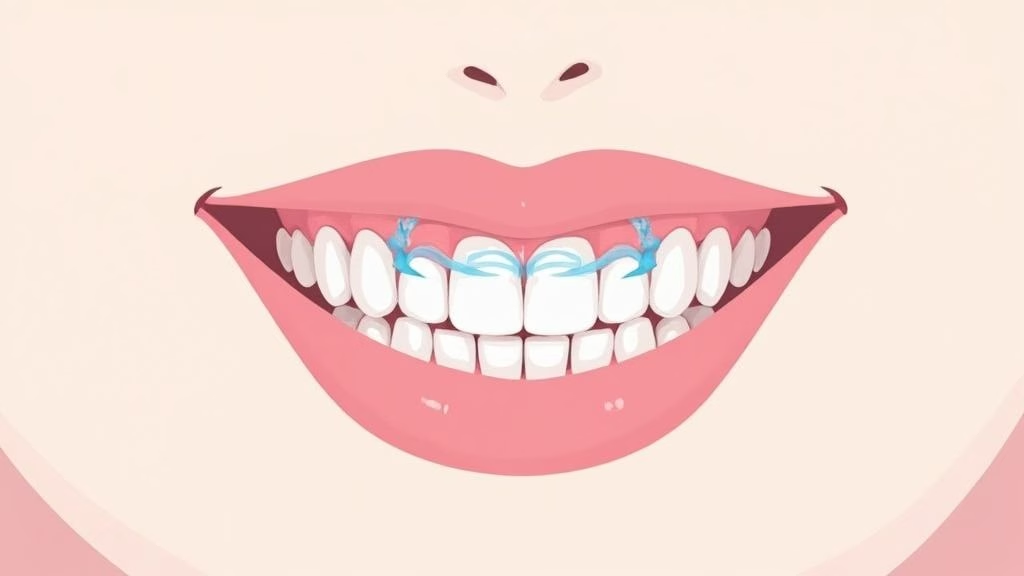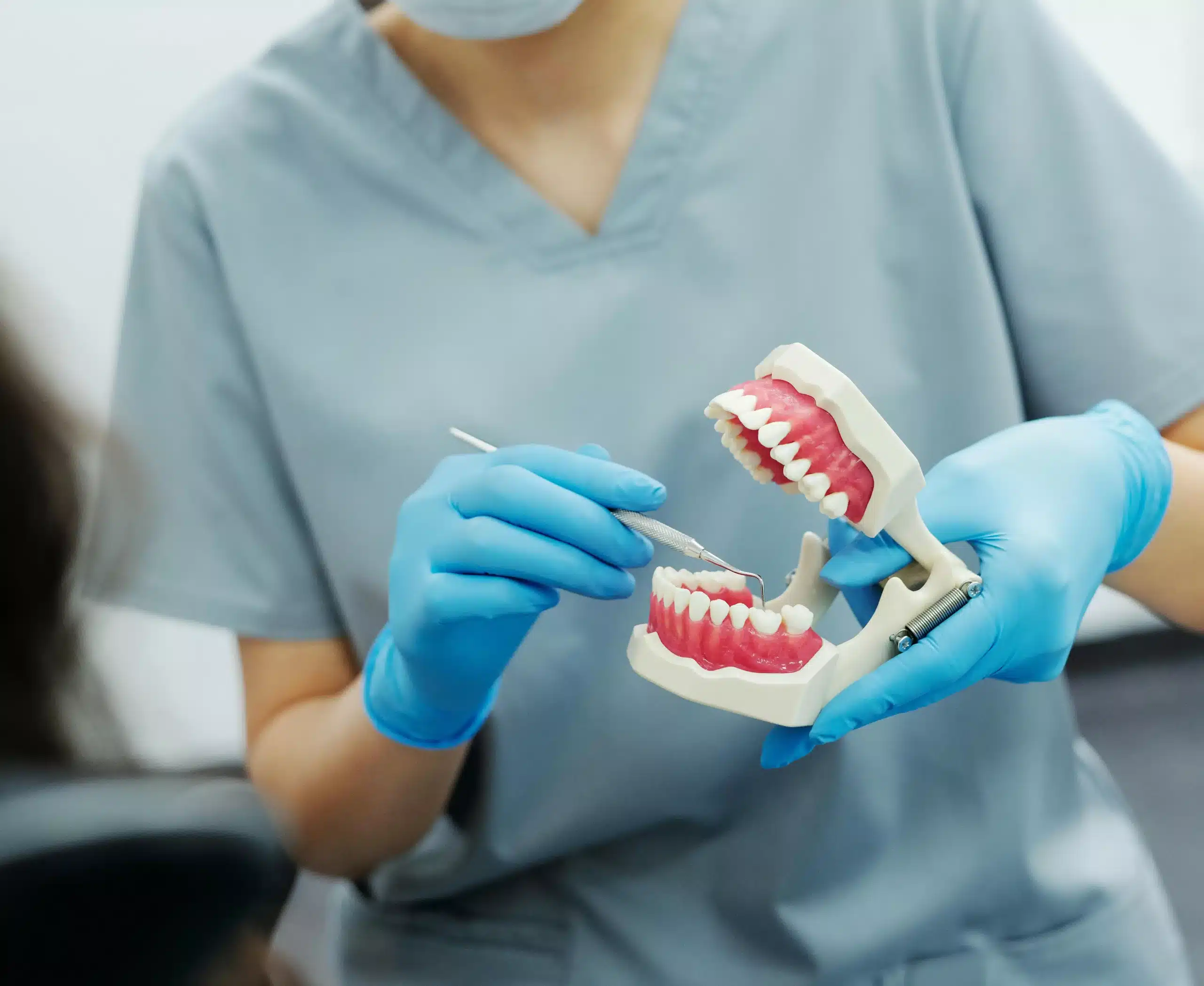What is Gum Disease Treatment? Expert Solutions & Care Tips
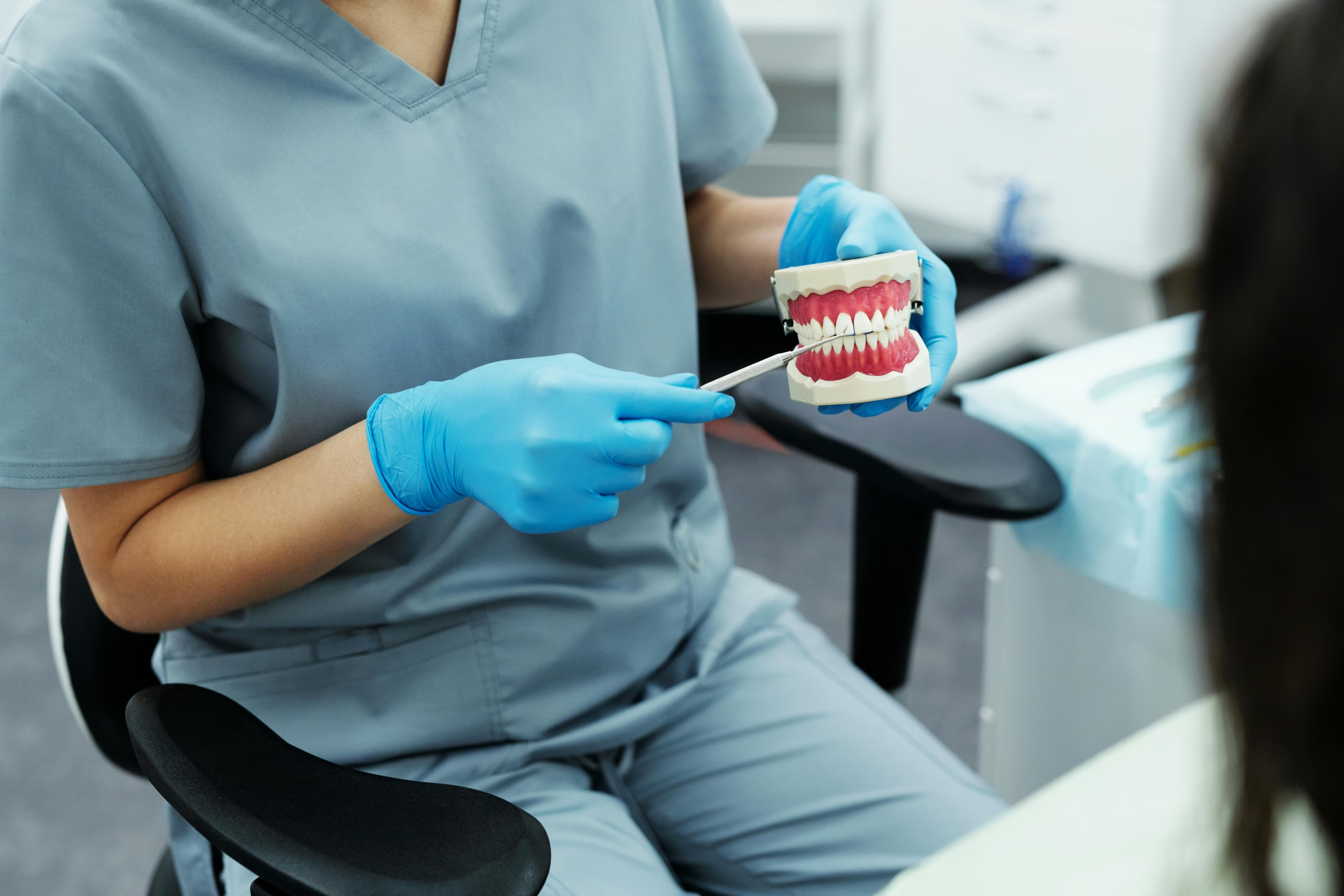
Gum disease treatment is a combination of professional dental work and dedicated at-home care. The whole point is to get rid of the harmful bacteria causing the problem, calm down the inflammation, and bring your gums and the bone underneath back to good health. Ultimately, the goal is to stop the disease in its tracks and prevent tooth loss, giving you a solid, healthy foundation for your smile.
Understanding Gum Disease and Its Stages
Think of your gums as the foundation of a house, with your teeth being the house itself. If that foundation starts to weaken or crumble, you’re heading for serious trouble. Gum disease often starts quietly, almost unnoticed, but it can quickly escalate. That’s why it’s so important to understand what you’re dealing with.
So, what is gum disease treatment? It’s a targeted plan of attack, designed specifically for the stage of the disease you’re at. Getting your gums back to health isn’t a one-off fix; it’s a process that starts with knowing which of the two main phases you’re in, as each requires a different approach.
To make this clearer, let’s break down the stages and what we’re trying to achieve with treatment for each one.
Stages of Gum Disease and Initial Treatment Goals
| Stage of Gum Disease | Common Symptoms | Primary Treatment Goal |
|---|---|---|
| Gingivitis | Red, swollen gums; bleeding when brushing or flossing. | Reversal and Prevention. Remove plaque and tartar to allow gums to heal completely and prevent progression to periodontitis. |
| Periodontitis | Receding gums, deep pockets between teeth and gums, loose teeth, persistent bad breath. | Management and Stabilisation. Halt the progression of bone and tissue loss to save existing teeth and prevent further damage. |
As you can see, the approach shifts from a complete cure in the early stage to long-term management once things become more serious.
Gingivitis: The Reversible First Stage
Gingivitis is the earliest and mildest form of gum disease. If you imagine your gums are like the soil in a garden, the plaque that builds up along your gumline is like weeds starting to sprout. This sticky film of bacteria irritates the gums, making them red, swollen, and likely to bleed a bit when you brush.
The fantastic news is that gingivitis is 100% reversible. At this point, the “weeds” haven’t yet damaged the deeper structures—the bone and connective tissues holding your teeth in place. A professional cleaning followed by a consistent home care routine is usually all it takes to clear out the bacteria and let your gums heal, returning them to their firm, healthy state.
Periodontitis: The Advanced Stage
If gingivitis is ignored, it can advance into periodontitis, which is a much more serious problem. This is where the infection has worked its way below the gumline, starting to destroy the bone and fibres that anchor your teeth. Pockets form between your gums and teeth, creating the perfect hideout for more bacteria to gather, safe from your toothbrush.
This simple diagram really highlights the difference between the two stages.
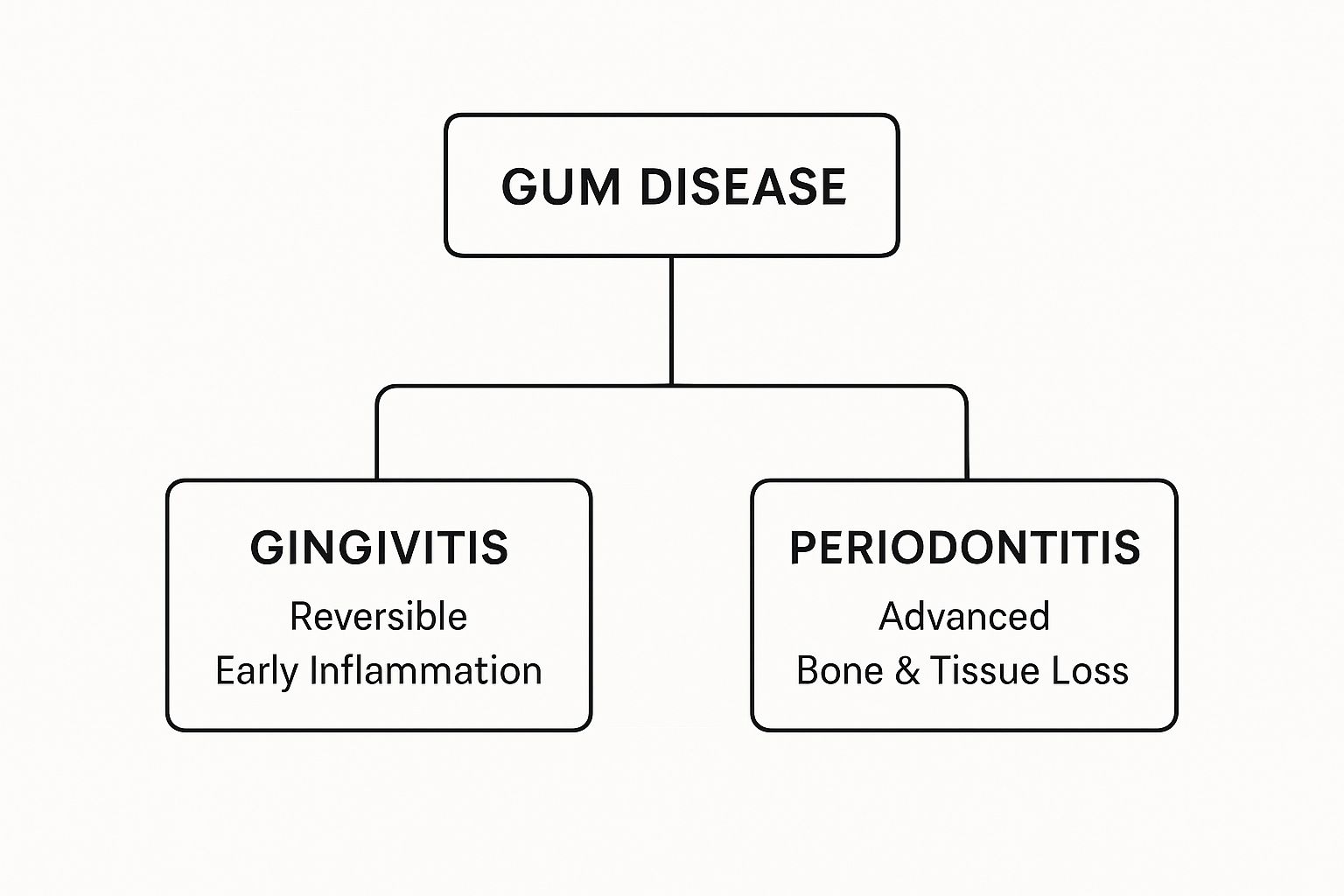
As the image shows, gingivitis is all about surface-level inflammation. Periodontitis, on the other hand, involves permanent damage to tissue and bone. Unlike gingivitis, you can’t reverse the damage from periodontitis. Treatment shifts to stopping the disease from getting any worse and preventing tooth loss.
This cumulative damage is why gum health becomes more critical as we age. For example, the Adult Oral Health Survey 2021 shows that in the UK, self-reported gum disease jumps from just 4% of people aged 16–24 to a staggering 28% for those aged 55 and over.
Your First Line of Defence: Non-Surgical Treatments
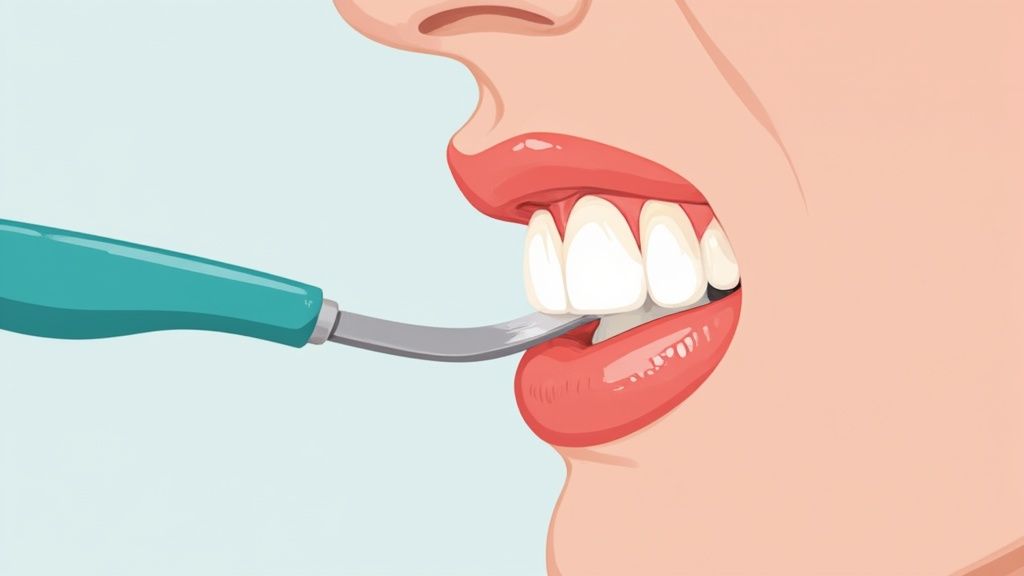
When we first spot the signs of early-stage gum disease, the go-to approach is almost always non-surgical. These treatments are the cornerstone of care, designed to halt the disease in its tracks before it causes any lasting damage. Think of them as the essential first-response team for your oral health.
The primary goal is pretty straightforward: get rid of the source of the infection. This means clearing away the plaque and tartar (which is just hardened plaque) that have built up on your teeth, especially along the gumline. Once that’s gone, your gums get the chance they need to heal and reattach firmly to your teeth, just as they’re meant to.
Professional Scaling and Polishing
The most common procedure is a professional scale and polish. It might sound like a routine clean, but it’s a critical first step in treating gum disease. The ‘scaling’ part is where your dentist or hygienist meticulously removes tartar from the tooth surfaces, both above and just below the gumline.
This isn’t a job you can tackle at home with a toothbrush. Tartar is incredibly hard and clings on stubbornly. Afterwards, the ‘polishing’ step smooths out your teeth, making it much harder for new plaque to get a foothold. This procedure is absolutely fundamental to UK dental care.
Official data really backs this up. In England during 2023/24, an impressive 31% of all adult courses of NHS dental treatment included a scale and polish. This figure, highlighted in the latest NHS report, shows just how central it is to keeping our gums healthy.
It’s a clear reminder of why regular dental check-ups are so crucial, even if you’re focused on cosmetic work like teeth straightening. You need a healthy foundation first.
Deep Cleaning Below the Gums
If the gum infection has progressed a bit further, creating shallow pockets between your teeth and gums, we need to go deeper. This is where a procedure called root planing comes in.
Here’s a good way to think about it: imagine your gums are like the edges of a fitted carpet. Plaque and bacteria can easily sneak underneath, into places you just can’t reach. Root planing is like carefully lifting those edges to deep clean the floorboards underneath—in this case, the roots of your teeth.
The whole point of root planing is to smooth out the root surfaces, getting rid of bacterial toxins and tartar. This encourages your gums to heal and reattach snugly to the tooth, closing up those pockets where harmful bacteria love to hide.
This treatment is usually done with a local anaesthetic to make sure you’re completely comfortable. It’s an incredibly effective way to manage the early stages of periodontitis without resorting to surgery.
What to Expect After Treatment
It’s normal to have some sensitivity right after these non-surgical treatments, but this usually settles down quickly. Your dentist will give you specific aftercare instructions, and it’s vital to follow them to ensure everything heals properly.
Here’s a quick rundown of what’s typical:
- Mild Discomfort: Your gums might feel a bit tender for a day or two. This is easily managed with over-the-counter pain relief.
- Gentle Hygiene: You’ll need to be extra gentle when brushing and flossing around the treated areas for a little while.
- Dietary Adjustments: Sticking to softer foods for a couple of days can prevent irritation and give your gums the best chance to heal.
By tackling the problem early with these methods, you have an excellent chance of reversing gingivitis and getting periodontitis under control, protecting your smile for years to come.
Taking the Next Step: When Surgery is Necessary
Sometimes, despite our best efforts with deep cleaning, advanced gum disease just digs in too deep. When non-surgical treatments can no longer keep the infection at bay, it’s time to consider a surgical approach.
The thought of surgery can be a bit intimidating, I know. But it’s important to see these procedures for what they are: highly effective, precise techniques designed to save your teeth and rebuild the foundation of your smile. They allow us to get to the root of the problem—quite literally—addressing damage far below the gumline where cleaning tools simply can’t reach.
At this stage, we’re not just cleaning anymore. We’re actively repairing the damage caused by periodontitis and creating a healthy environment for your gums to reattach to your teeth.
Flap Surgery: Getting a Deeper Clean
One of the most common and effective procedures is called flap surgery, which you might also hear referred to as pocket reduction. Think of it like a specialist needing to get under the floorboards to fix a deep-rooted problem in your house.
Your periodontist makes tiny, careful incisions to gently lift the gum tissue away, creating a small “flap”. This gives us a clear view of the tooth roots and the surrounding bone.
With this direct access, we can perform an incredibly thorough cleaning, removing all the stubborn tartar and bacteria that have been hiding in those deep pockets. Sometimes, we might also smooth the bone surface to get rid of rough spots where bacteria love to gather. Once everything is perfectly clean, the gums are repositioned to fit more snugly around the teeth and secured with tiny stitches.
By making the pockets shallower, flap surgery essentially evicts the harmful bacteria from their hiding spots. This not only resolves the current infection but makes your daily brushing and flossing at home much more effective long-term.
Rebuilding Your Smile: Bone and Tissue Grafts
Unfortunately, severe periodontitis can destroy the very bone and gum tissue that hold your teeth in place. It’s a bit like coastal erosion washing away the land supporting a cliffside home. When this happens, we have some amazing techniques to rebuild what’s been lost.
- Bone Grafts: If you’ve lost bone around a tooth, a graft acts like a scaffold to encourage new growth. We can use tiny fragments of your own bone, a synthetic material, or donated bone to fill in the area. Over time, your body uses this scaffold to regenerate its own bone, strengthening the tooth’s foundation.
- Soft Tissue Grafts: Gum recession is a common side effect, leaving tooth roots exposed. To fix this, we can perform a soft tissue graft. This usually involves taking a small piece of tissue from the roof of your mouth and attaching it where the gums have receded, covering the exposed root and protecting it from further damage.
These treatments are a powerful part of modern dentistry, giving us the tools to halt serious gum disease and prevent tooth loss. They represent the definitive answer when the condition has caused significant structural damage, paving the way to restoring your mouth to full health and function.
The Power of Your Daily At-Home Care Routine
Think of professional gum treatment as hitting the reset button—it’s the deep clean that gets rid of stubborn bacteria your toothbrush just can’t handle. But what you do every single day afterwards is what really makes the difference in the long run.
It’s a bit like having your car professionally detailed. It looks incredible when you get it back, but if you don’t wash it regularly, it’s not going to stay that way for long. Your daily oral hygiene routine is that essential maintenance, protecting your investment and stopping plaque from making a comeback.
Without a solid home care plan, the benefits of even the best dental work will eventually diminish. This is where you really take control of your oral health for good.
Mastering the Basics of Brushing and Cleaning
An effective daily routine isn’t about spending hours in the bathroom; it’s about having the right technique. The goal is to break up plaque before it has a chance to harden into tartar, and doing that consistently is the secret to healthy gums.
Let’s get back to the fundamentals that keep your gums in great shape:
- Proper Brushing Technique: Grab a soft-bristled brush and angle it at 45 degrees towards your gumline. Use gentle, circular motions to clean every surface of your teeth—the outside, inside, and chewing surfaces. This approach cleans effectively without being too harsh on sensitive gums.
- Cleaning Between Your Teeth: This is absolutely non-negotiable for gum health. Flossing or using interdental brushes every day clears out plaque from those tight spots your toothbrush misses. It’s often in these little gaps that gum problems first start.
- Choosing the Right Products: A good fluoride toothpaste is a must for strengthening enamel. If your gums are a bit sensitive, an antimicrobial mouthwash can be a helpful addition to reduce bacteria, but remember it’s a sidekick to brushing and flossing, not a replacement.
These simple habits are the bedrock of any successful gum disease treatment. Of course, keeping your gums healthy is part of a bigger picture. For a more comprehensive look, this practical guide to improving overall dental health offers some great insights.
Lifestyle Choices That Impact Your Gums
Beyond the bathroom sink, your daily habits have a massive impact on your gum health. What you eat and how you live can either supercharge your efforts or completely undermine them.
A healthy lifestyle directly translates to healthier gums. Your mouth is a window to your overall well-being, and choices that benefit your body will also benefit your smile, making your at-home care routine even more effective.
For example, a diet packed with sugary foods and drinks is like a buffet for the bad bacteria in your mouth, speeding up plaque build-up. On the other hand, a balanced diet full of vitamins and minerals, especially Vitamin C, strengthens your gum tissue’s ability to heal and fight off infection.
And then there’s smoking, which is one of the biggest risk factors for gum disease. It weakens your immune system, making it much harder for your body to fight gum infections, and it can seriously slow down healing after treatment. Kicking the habit is one of the single best things you can do for your smile.
How Gum Health Paves the Way for Your Dream Smile
We all want a smile that’s straight, white, and full of confidence. But before you jump into any cosmetic work, there’s a crucial first step: making sure your gums are in great shape. Think of it like building a house – you wouldn’t put up the walls and roof on a shaky foundation, would you? Your gums are the foundation for your teeth.
Trying to straighten your teeth with aligners when you have active gum disease is a recipe for disaster. The pressure from the aligners can actually make the infection worse, speed up bone loss, and in some serious cases, even cause you to lose teeth. It’s a gamble that’s just not worth taking with your health.
Health First, Aesthetics Second
So, what’s the right way to do it? The very first step in any smile makeover plan should always be a comprehensive gum health check-up with your dentist. This is to make sure the bone and gum tissue are strong and healthy enough to handle the movement and changes that come with cosmetic treatments.
Getting that all-clear from your dentist is like getting the green light to safely start your journey towards the smile you’ve always wanted. Once you know your foundation is solid, you can confidently start looking at ways to achieve your cosmetic goals.
“A beautiful smile is a healthy smile. Treating underlying gum issues first doesn’t delay your cosmetic goals; it secures them. A solid foundation ensures your final result is not only stunning but also sustainable for a lifetime.”
A Smarter Path to a Straighter Smile
After you’ve successfully treated any gum disease and your oral health is on solid ground, the fun part can begin. The good news is that old-fashioned, expensive methods are no longer the only way to straighten your teeth. Today, there are far more convenient and affordable routes to the smile you want.
You might get a quote from a specific aligner brand that involves a hefty price tag and a long series of in-person appointments, which can be a real hurdle for many people. This is where modern alternatives are changing the game.
At Toothfairy, we’re passionate about making a beautiful smile accessible to everyone. We offer a dentist-supervised, affordable way to straighten teeth, get help with dental emergencies, or get cosmetic dental work right from your own home. By making sure your gums are healthy first, we help you build that dream smile on a foundation that’s genuinely strong and stable, making your cosmetic goals both safe and achievable.
So, What’s Your Next Move for Healthier Gums?
You’ve now got a solid understanding of what tackling gum disease really looks like. It’s a team effort, combining professional deep cleaning with the small, consistent habits you build at home. Every little action helps create a stronger, healthier foundation for your teeth and smile. The key thing to remember is that gum disease is absolutely treatable, and you’re now equipped to face it head-on.
The first move is always to get a clear picture of what’s going on in your mouth. That means booking in for a professional consultation to figure out exactly where your gum health is at. This isn’t just about finding problems; it’s about creating a straightforward, practical plan that’s right for you. And remember, expert guidance is always on hand to help you along the way.
Your Practical Gum Health Checklist
Feeling in control starts with knowing what to do. Use this simple checklist to see how your current routine stacks up and decide on your next step.
- Take an Honest Look at Your Routine: Are you really brushing twice a day for a full two minutes? Is your toothbrush angled towards the gum line? And are you cleaning between your teeth every single day? Be honest with yourself—it’s the only way to improve.
- Spot the Early Warnings: Keep an eye out for any bleeding when you brush, gums that look red or puffy, or bad breath that just won’t go away. Catching these signs early makes treatment a whole lot easier.
- Book That Professional Check-Up: This one’s non-negotiable. Only a dentist or hygienist can properly assess the health of your gums and create a treatment plan that will actually work.
Taking proactive steps for your gum health is one of the best investments you can make in your overall well-being. A healthy mouth truly supports a healthy body, and that journey can start today.
Common Questions About Gum Disease Treatment
If you’re looking into gum disease treatment, you probably have a lot of questions. Let’s tackle some of the most common ones that we hear from patients across the UK.
Is Gum Disease Treatment Painful?
This is a big worry for many people, but the short answer is no, it shouldn’t be. Most non-surgical treatments, like a deep clean, are done using a local anaesthetic. This completely numbs the area, so you won’t feel any pain during the procedure.
Afterwards, it’s normal to have some slight tenderness or sensitivity in your gums for a day or two, but this is usually very manageable. If you need a surgical procedure, your dentist will ensure you’re fully anaesthetised and will give you a detailed aftercare plan to keep you comfortable while you heal.
Can Gum Disease Be Cured Completely?
It all depends on the stage. The very early stage, gingivitis, is completely reversible. With a professional clean and a solid home care routine, you can get your gums back to full health. This is exactly why it’s so important to catch it early.
Once it progresses to periodontitis, things change. Periodontitis is a chronic condition, meaning it’s managed for the long term rather than completely cured. The bone loss that happens at this stage is, unfortunately, permanent. The main goal of treatment then becomes halting the disease in its tracks, preventing tooth loss, and keeping your mouth stable and healthy for the long run.
How Much Does Gum Disease Treatment Cost in the UK?
The cost really varies depending on what you need. A simple scale and polish on the NHS is a Band 1 treatment, but more complex work will fall into higher-cost bands.
In the private sector, prices can differ significantly from one clinic to another. The best approach is always to ask for a detailed treatment plan upfront, which should include a full breakdown of the costs.
Finding a path to dental care that is both high-quality and affordable is a real concern for many people. It’s crucial to look at all the modern options available that don’t force you to compromise.
Companies like Toothfairy are changing the game by making all kinds of dental care, from cosmetic treatments to emergency appointments, easier to access and afford for everyone.
Ready to take the next step towards a healthier, more confident smile? Whether you’re considering cosmetic work or need expert advice, Toothfairy offers a smarter, more affordable way to access professional dental care. Visit https://www.toothfairyapp.co.uk to learn more.
Last updated on October 13, 2025

Dr. Deepak
ToothFairy Care Team.
Dr. Deepak
ToothFairy Care Team.

